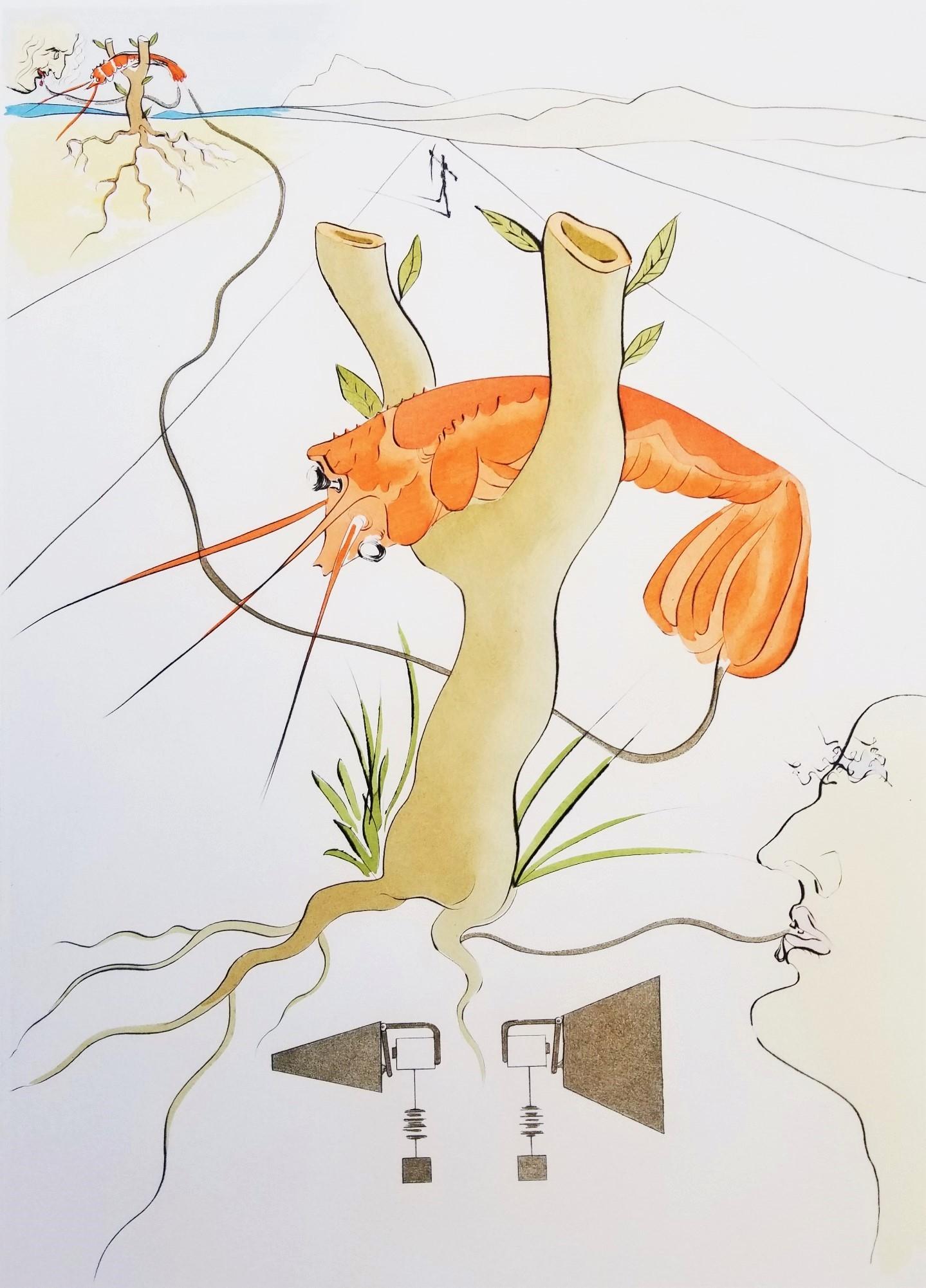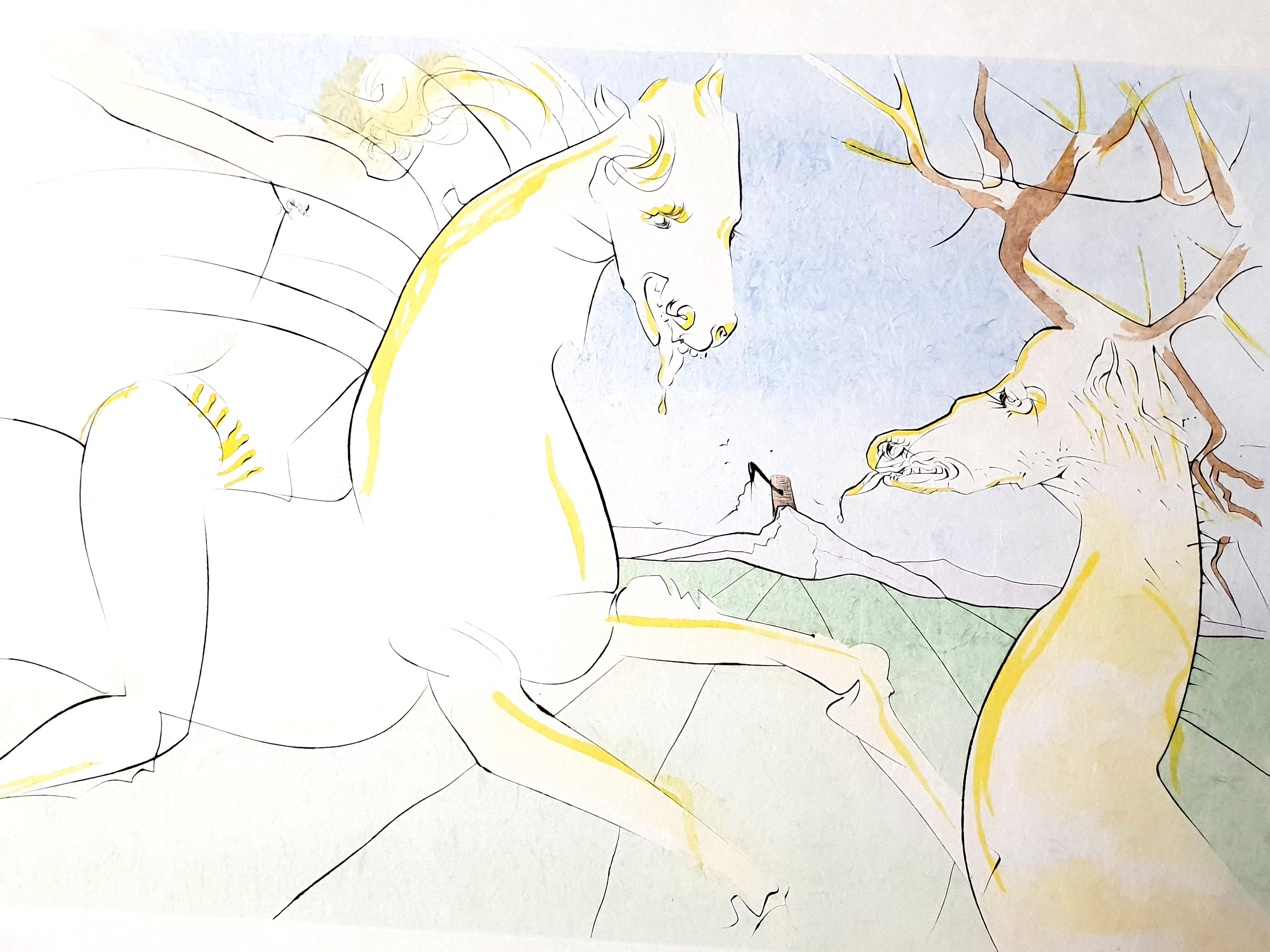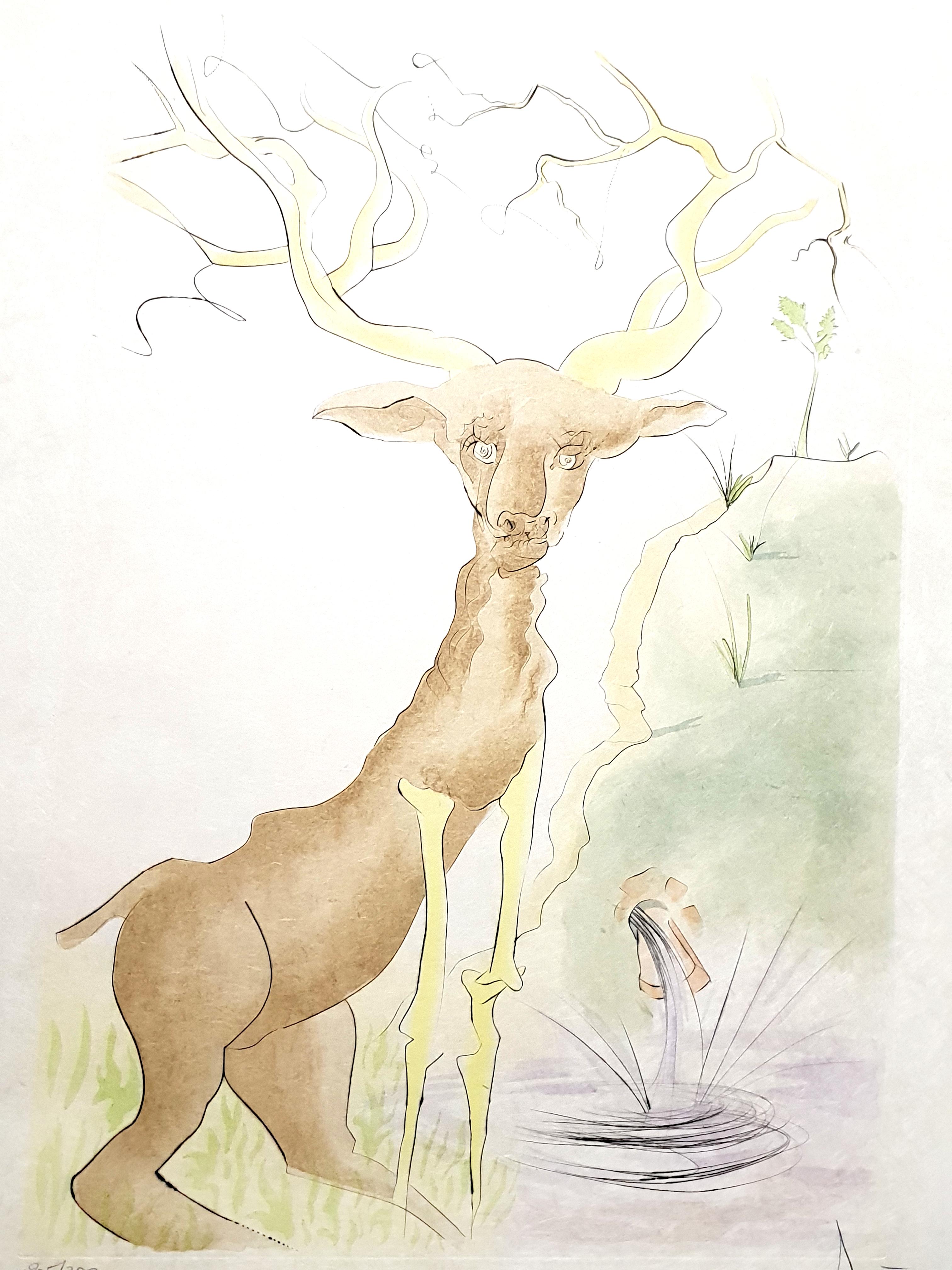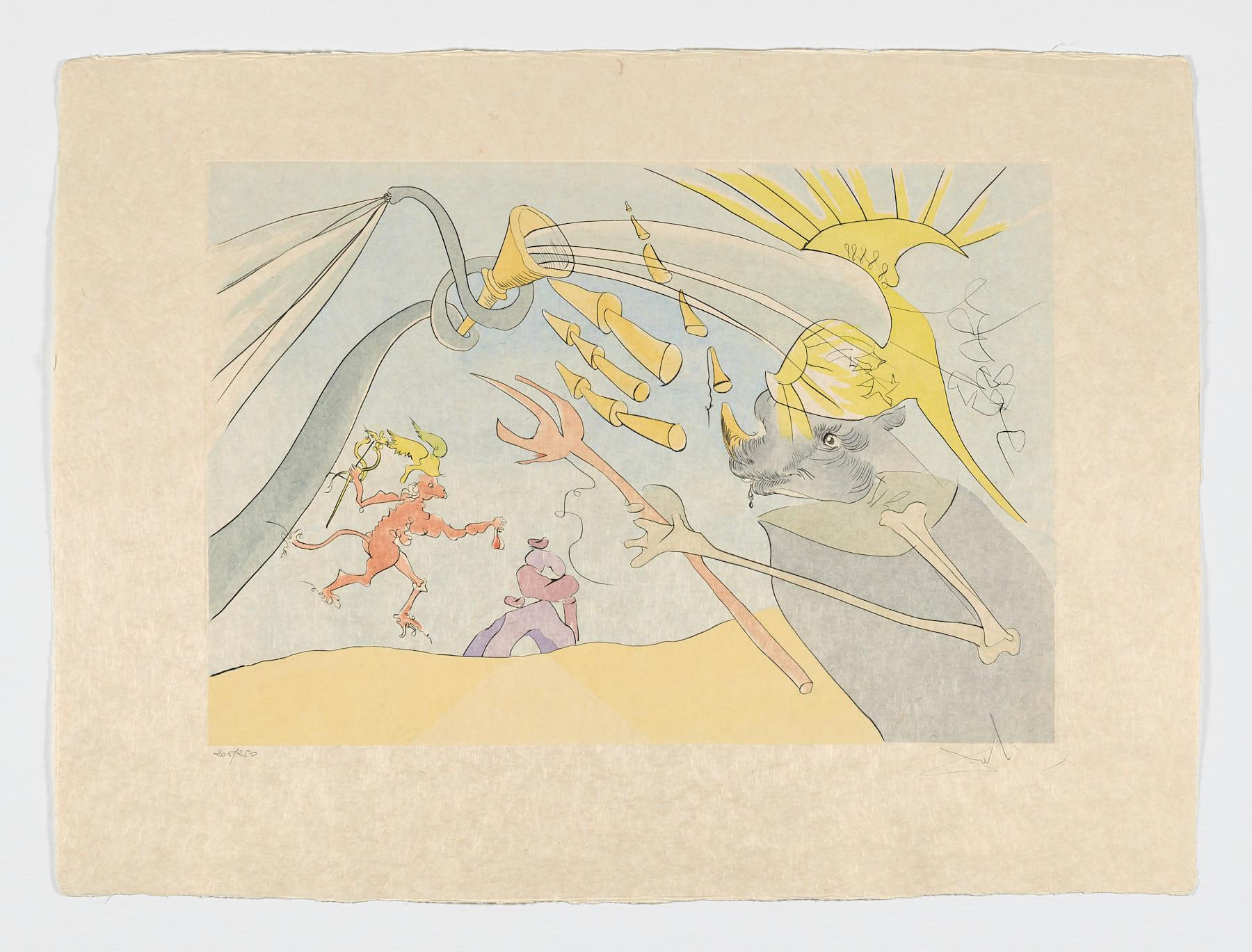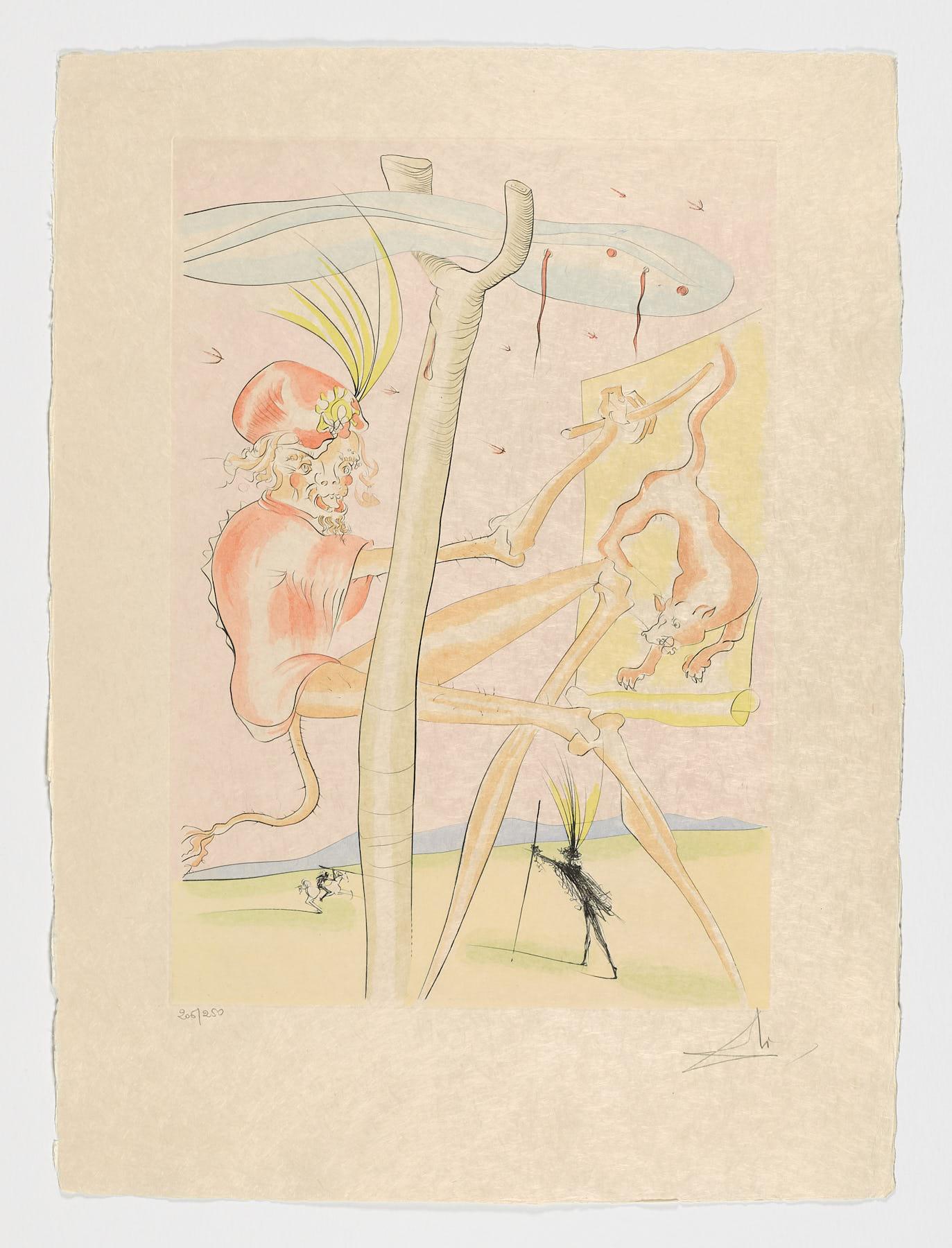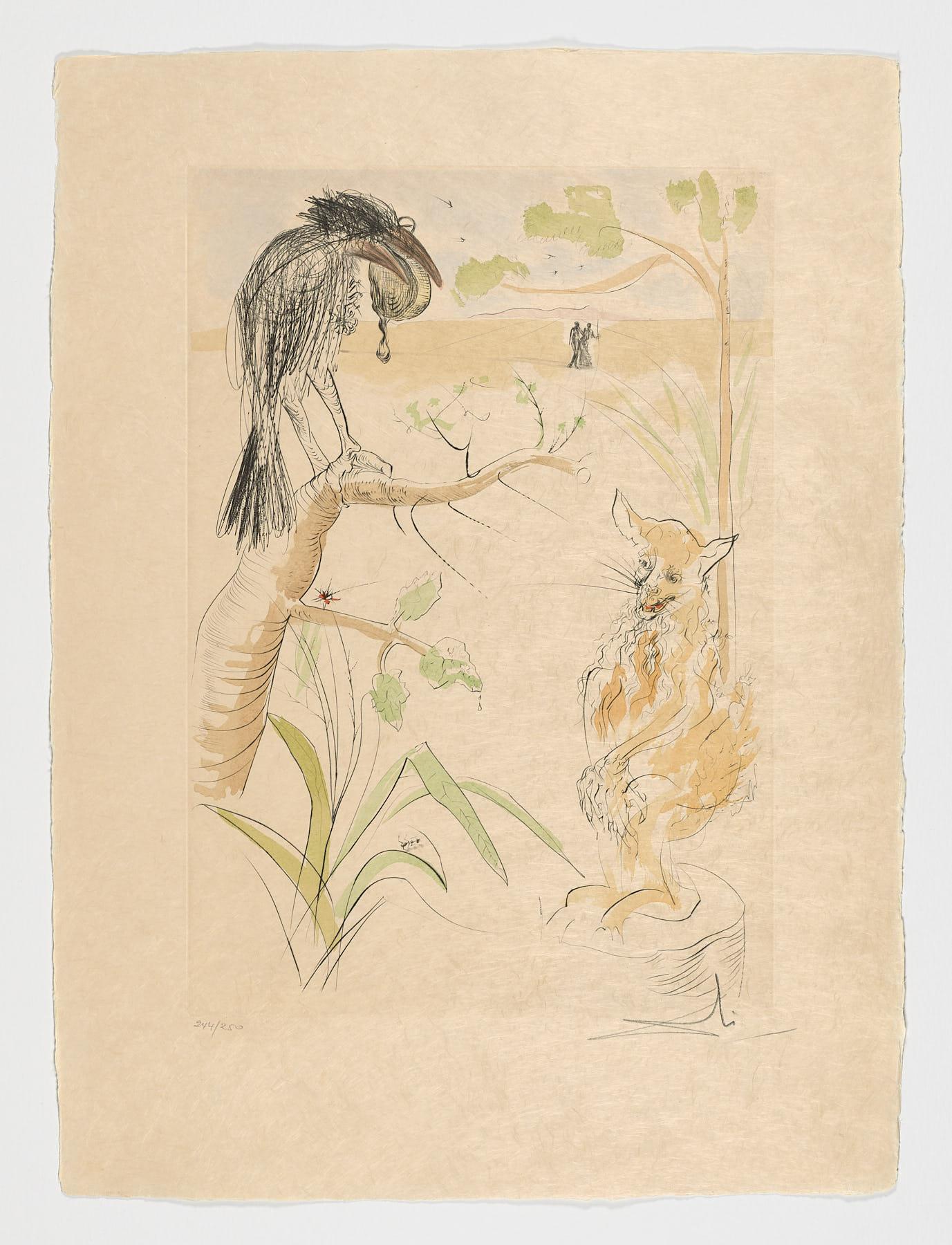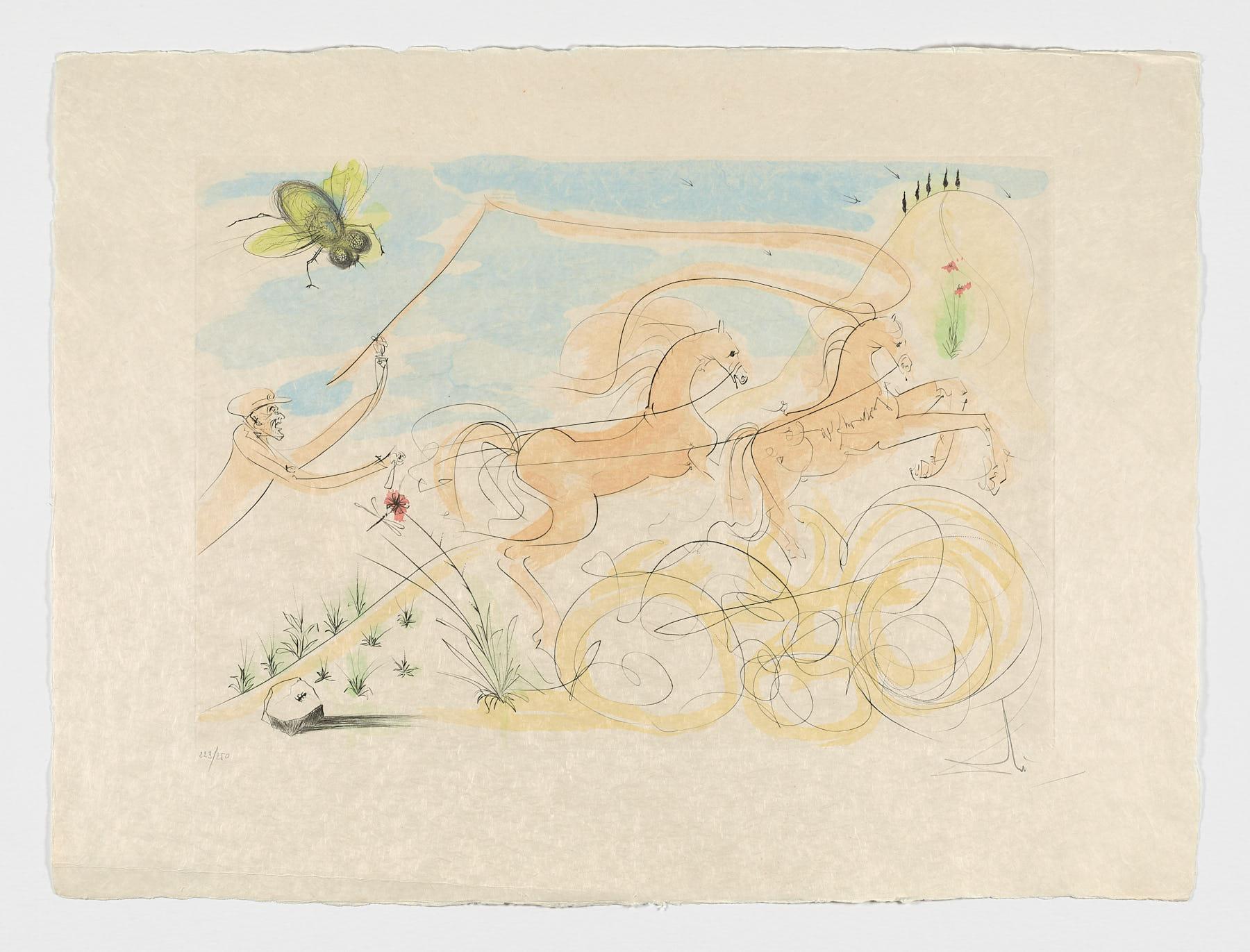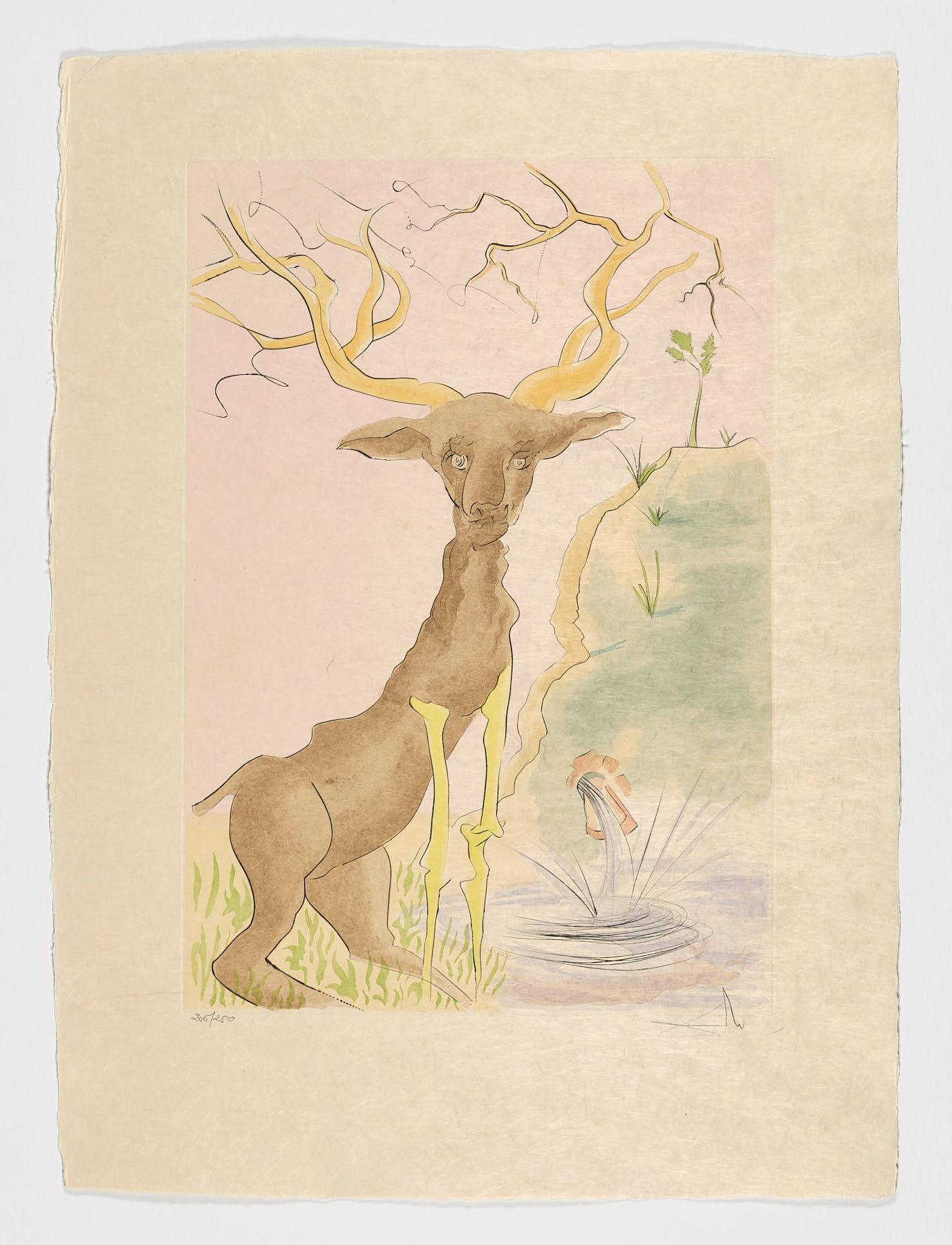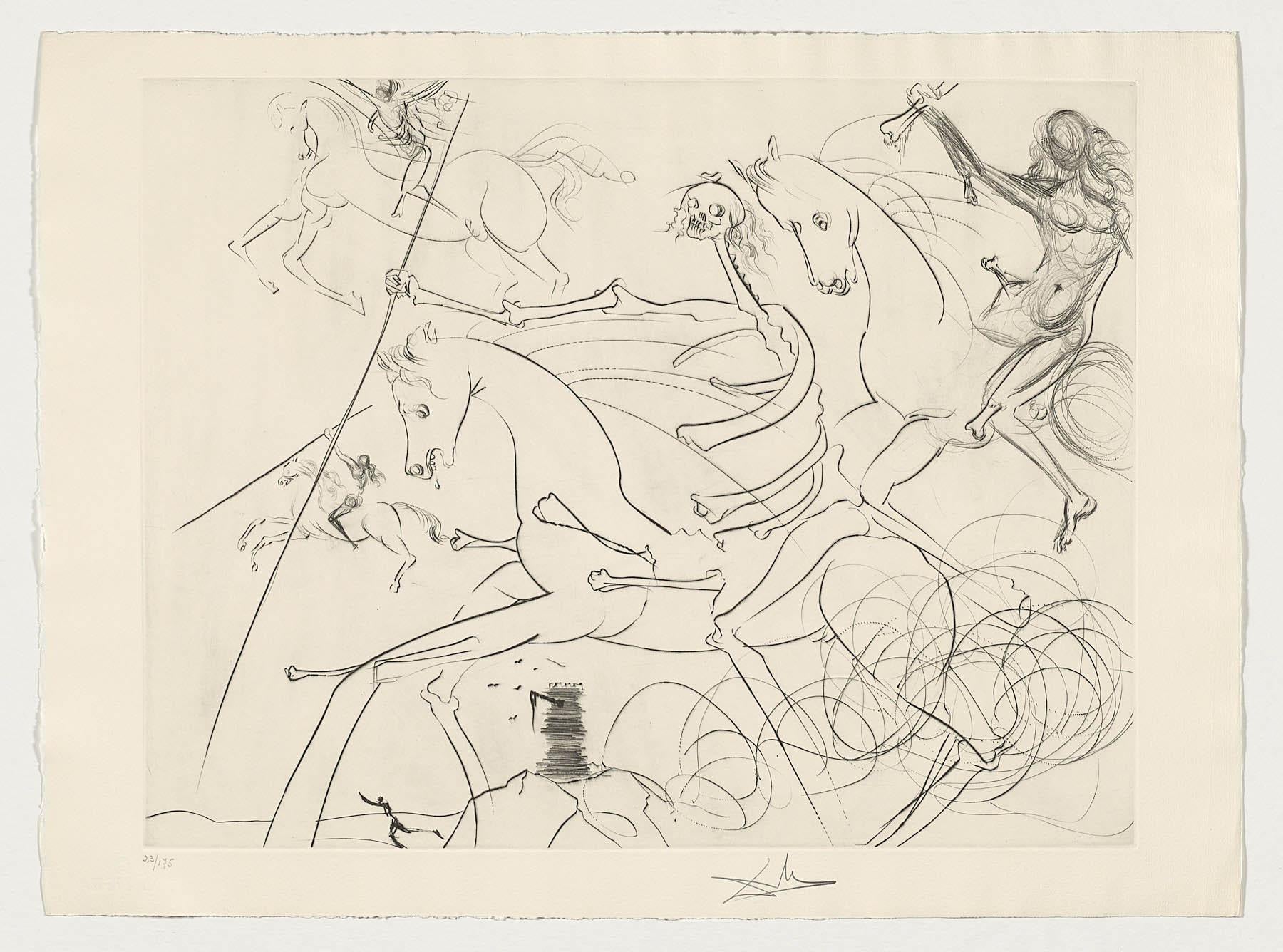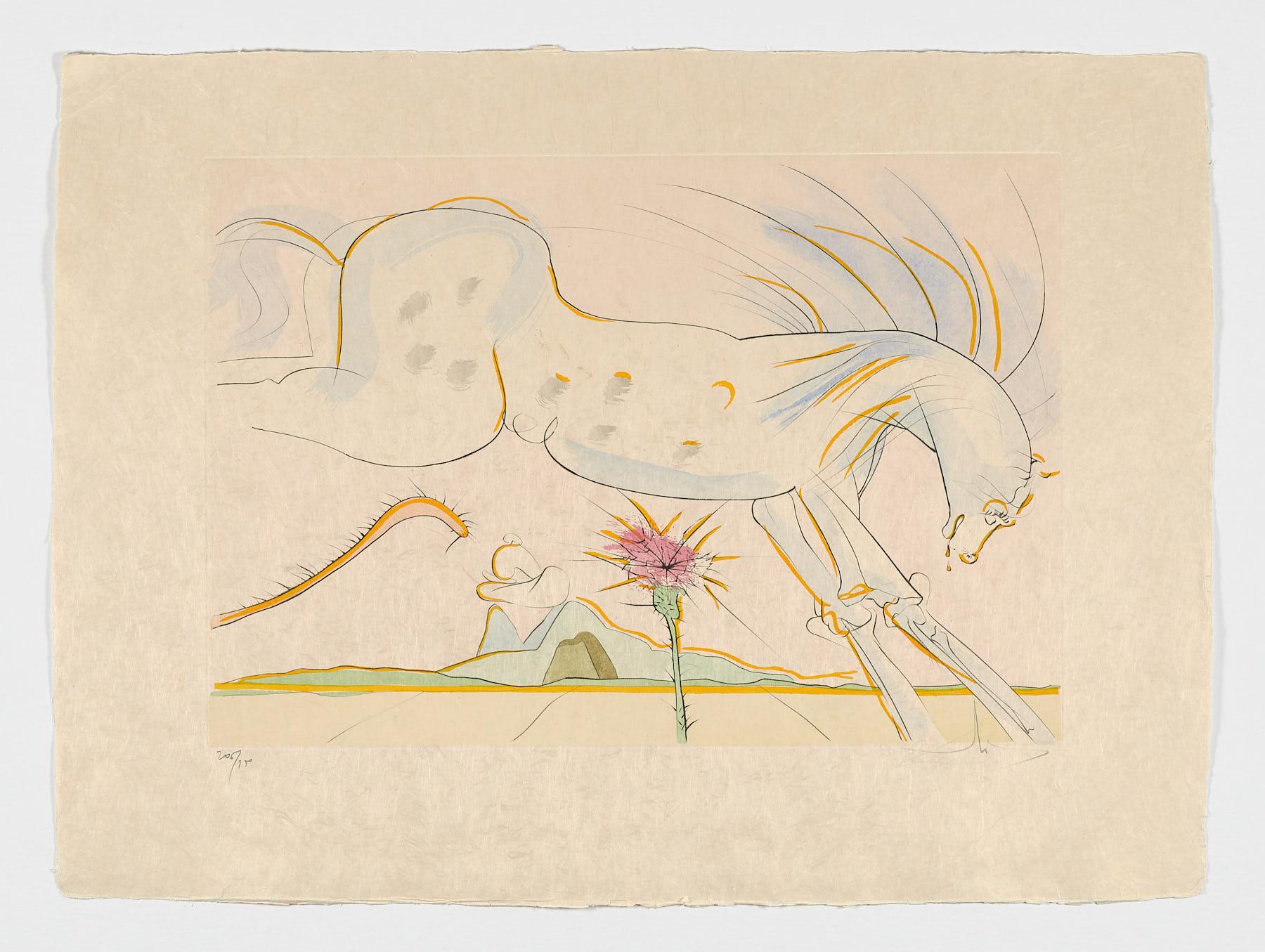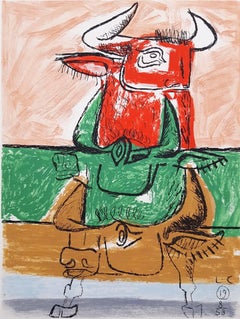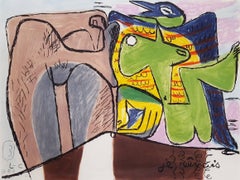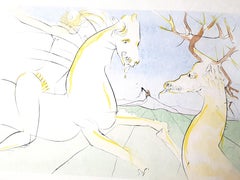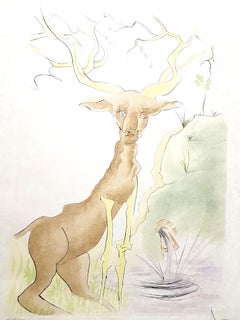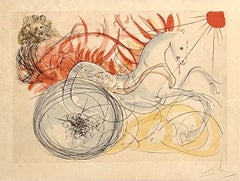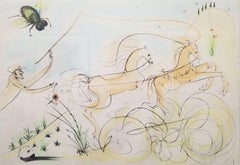
Le Coche et le Mouche (The Coach and the Fly)
View Similar Items
Salvador DalíLe Coche et le Mouche (The Coach and the Fly)1974
1974
About the Item
- Creator:Salvador Dalí (1904 - 1989, Spanish)
- Creation Year:1974
- Dimensions:Height: 27.5 in (69.85 cm)Width: 34.5 in (87.63 cm)
- Medium:
- Movement & Style:
- Period:
- Condition:
- Gallery Location:Saint Augustine, FL
- Reference Number:1stDibs: LU12123930942
Salvador Dalí
Instantly recognizable by his waxed, upturned mustache, the flamboyant Salvador Dalí is one of modern art’s most distinctive figures. He is also one of the icons of the 20-century avant-garde Surrealist movement, whose dreamlike images, drawn from the depths of the unconscious, he deployed in paintings, sculptures, prints and fashion, as well as in film collaborations with Luis Buñuel and Alfred Hitchcock.
Dalí was born in Figueres, Catalonia, and even as a youngster, displayed the sensitivity, sharp perception and vivid imagination that would later define his artworks. In these, he conjured childhood memories and employed religious symbols and Freudian imagery like staircases, keys and dripping candles to create unexpected, often shocking pieces.
Dalí's use of hyperrealism in conveying Surrealist symbols and concepts that subvert accepted notions of reality is epitomized in what is perhaps his most recognizable painting, The Persistence of Memory (1931), in which he depicts the fluidity of time through melting clocks, their forms inspired by Camembert cheese melting in the sun. His artistic genius, eccentric personality and eternal quest for fame made him a global celebrity.
“Each morning when I awake, I experience again a supreme pleasure,” he once said. “That of being Salvador Dalí.”
Find original Salvador Dalí paintings, prints, sculptures and other works on 1stDibs.
- Le Téléphone (Lobster Telephone) /// Surrealism Salvador Dali Engraving ModernBy Salvador DalíLocated in Saint Augustine, FLArtist: Salvador Dali (Spanish, 1904-1989) Title: "Le Téléphone (Lobster Telephone)" Portfolio: Hommage à Leonardo da Vinci (Great Inventions) *Signe...Category
1970s Surrealist Animal Prints
MaterialsIntaglio, Etching, Engraving
- Unité, Planche 19 (Set of 2) /// Surrealism Modern Art Le Corbusier Bull CowBy Le CorbusierLocated in Saint Augustine, FLArtist: Le Corbusier (Charles-Édouard Jeanneret) (Swiss-French, 1887-1965) Title: "Unité, Planche 19" (Set of 2) Portfolio: Unité *Signed by Le Corbusier in pencil lower right. It is...Category
1960s Surrealist Animal Prints
MaterialsEtching, Aquatint, Intaglio
- Unité, Planche 3 (Set of 2) /// Surrealism Le Corbusier Etching Modern AquatintBy Le CorbusierLocated in Saint Augustine, FLArtist: Le Corbusier (Charles-Édouard Jeanneret) (Swiss-French, 1887-1965) Title: "Unité, Planche 3" (Set of 2) Portfolio: Unité *Signed by Le Corbusier in pencil lower right. It is ...Category
1960s Surrealist Animal Prints
MaterialsEtching, Aquatint, Intaglio
- Sandwich Tern (with Florida Cray Fish) (Florida Keys) /// Ornithology AudubonBy John James AudubonLocated in Saint Augustine, FLArtist: John James Audubon (American, 1785-1851) Title: "Sandwich Tern (with Florida Cray Fish) (Florida Keys)" (Plate CCLXXIX - 279; part No. 56) Portfo...Category
1830s Victorian Animal Prints
MaterialsGold Leaf
- Tropic Bird /// Ornithology John James Audubon Shorebird Ocean Beach SeascapeBy John James AudubonLocated in Saint Augustine, FLArtist: John James Audubon (American, 1785-1851) Title: "Tropic Bird" (Plate CCLXII - 262; part No. 53) Portfolio: The Birds of America, Havell Edition Year: 1835 Medium: Original Hand-Colored Engraving with Aquatint on double-elephant folio, J. Whatman paper Limited edition: approx. 180 Printer: Robert Havell Jr., London, England Publisher: John James Audubon, London, England Framing: Not framed, but matted in a handmade custom French matting Matted size: 30" x 38.75" Sheet size: 25.5" x 36" Platemark size: 20.75" x 30.25" Image size: 18.5" x 27.75" Condition: A few tiny foxmarks. In excellent condition with clean paper and strong colors Rare Notes: Provenance: private collection - New York, NY. Engraved, printed, and hand-colored by English artist Robert Havell Jr. (1793-1878). Comes from Audubon's monumental book volume "The Birds of America", (Havell Edition, 1827-1838), which consists of 435 hand-colored, life-size prints, made from engraved plates, with each sheet originally measuring around 39" x 26". "J. Whatman 1835" watermark upper right. Based on a composition painted between 1832 and 1835. Audubon sailed the entire length of Florida, around the Keys and as far as the Dry Tortugas, from which, on another occasion, "The specimens - in the plate were taken - by my kind friend Robert Day, Esq. of the United States Revenue Cutter...Category
Early 1800s Victorian Animal Prints
MaterialsIntaglio, Watercolor, Engraving, Aquatint
- Le Divin Berger (The Divine Shepherd) /// Old Masters Boy Sheep Etching AntiqueLocated in Saint Augustine, FLArtist: Charles Waltner (French, 1846-1925) Title: "Le Divin Berger (The Divine Shepherd)" Portfolio: Gazette des Beaux-Arts Year: 1875 Medium: Original Etching and Drypoint on cream...Category
1870s Old Masters Animal Prints
MaterialsIntaglio, Etching, Drypoint, Laid Paper
- Salvador Dali - The Rider and the Deer - Handsigned EngravingBy Salvador DalíLocated in Collonge Bellerive, Geneve, CHSalvador Dali - The Rider and the Deer - Handsigned Engraving 1974 Hand signed by Dali Edition: /250 The dimensions of the image are 22.8 x 15.7 inches on 3...Category
1970s Surrealist Figurative Prints
MaterialsDrypoint, Aquatint
- Salvador Dali - Le Cerf from Le Bestiaire de la Fontaine - Signed EngravingBy Salvador DalíLocated in Collonge Bellerive, Geneve, CHSALVADOR DALI Le Cerf se voyant dans l'eau from Le Bestiaire de la Fontaine 1974 Hand signed by Dali Edition: /250 The dimensions of the image are 22.8 x 15.7 inches on 31 x 23.2 in...Category
1970s Surrealist Figurative Prints
MaterialsDrypoint, Aquatint
- Surrealist Salvador Dali Large Pochoir Etching Drypoint Lithograph Chariot RiderBy Salvador DalíLocated in Surfside, FLSalvador Dalí (1904-1989) – Spanish painter, graphic artist and sculptor. Drypoint with etching and pochoir on Japon paper "Elijah and the Chariot," 1975, (Horse and rider) from the "Our Historical Heritage" suite. Pencil signed along the lower right and numbered 53/250 along the lower left. Literature: Field 75-4 J Framed; Height: 29 in x width: 35 in. Mat opening 19.5 X 25.5. The Spanish artist’s extensive oeuvre not only includes watercolors, drawings and sculptures but also tapestries; here a fine example from the limited edition ‘The Twelve Tribes of Israel’ The tapestry was created after an etching by Salvador Dalí from 1973 with the title ‘The Tribe of Judah’, which the artist created as part of a suite to mark the 25th anniversary of the State of Israel, and in which he represented the twelve tribes of Israel. This vintage French tapestry is an impeccable textile re-creation of a rare Dali etching. This is a flat weave Aubusson style tapisserie. The edition size was 500. The tapestry is inscribed with woven ‘Salvador Dalí’ lower right Genre: Surrealism Subject: people, architecture rendering Medium: textile Salvador Dali (Spanish, 1904-1989) Salvador Dali is considered as the greatest original artist of the surrealist art movement and one of the greatest masters of art of the twentieth century. Dali began to study art at the Royal Academy of Art in Madrid. He was expelled twice and never took the final examinations. His opinion was that he was more qualified than those who should have examined him. In 1928 Dali went to Paris where he met the Spanish painters Pablo Picasso and Joan Miro. He established himself as the principal figure of a group of surrealist artists grouped around Andre Breton, who was something like the theoretical "schoolmaster" of surrealism. Years later Breton turned away from Dali accusing him of support of fascism, excessive self-presentation and financial greediness. By 1929 Dali had found his personal style that should make him famous - the world of the unconscious that is recalled during our dreams. The surrealist theory is based on the theories of the psychologist Dr. Sigmund Freud. Recurring images of burning giraffes and melting watches became the artist's surrealist trademarks. Along with Rene Magritte his is considered the greatest of the Surrealists. His great craftsmanship allowed him to execute his paintings in a nearly photo realistic style. No wonder that the artist was a great admirer of the vintage Italian Renaissance painter Raphael. Meeting Gala was the most important event in the artist's life and decisive for his future career. She was a Russian immigrant and ten years older than Dali. When he met her, she was married to Paul Eluard. In 1933 Salvador Dali had his first one-man show in New York. One year later he visited the U.S. for the first time supported by a loan of US$500 from Pablo Picasso. To evade World War II, Dali chose the U.S.A. as his permanent residence in 1940. He had a series of spectacular exhibitions, among others a great retrospective at the Museum of Modern Art in New York. He has worked in paining, sculpture, tapestry, Daum glass and prints. Dali became the darling of the American High Society. Celebrities like Jack Warner or Helena Rubinstein gave him commissions for portraits. His artworks became a popular trademark and besides painting he pursued other activities - jewelry and dated clothing designs for Coco Chanel or film making with Alfred Hitchcock. In 1948 Dali and Gala returned to Europe, spending most of their time either in their residence in Ligate/Spain or in Paris/France or in New York. Dali developed a lively interest in science, religion and history. He integrated things into his art that he had picked up from popular science...Category
1970s Surrealist Figurative Prints
MaterialsDrypoint, Etching, Lithograph
- Spanish Artist hand signed limited edition original art print drypoint n8By Salvador DalíLocated in Miami, FLSalvador Dali (Spain, 1904-1989) 'La Cour du Lion', 1974 Serie: Le Bestiaire de La Fontaine dry point, aquatint on japanese paper 30.8 x 22.9 in. (78 x 58 cm.) Edition of 250 Unframed ID: DAL2001-008 Hand-signed by author It appears reviewed in the catalog raisonné: The official catalog of the graphic works of Salvador Dalí. Albert Field. Page: 2/93. Nr. 74-1 C. ______________________________________________________ Salvador Felipe Jacinto Dalí i Domènech was a Spanish painter, sculptor, engraver, set designer and writer of the 20th century. An artist associated with surrealism, he is one of the most important figures in 20th century art, representing the archetype of the spectacular contemporary multifaceted artist. He develops his creative activity in various fields through the most diverse cultural formulas: painting, written media, performing arts, cinema, or public appearances in the press, radio, cinema, advertising, television, etc. Master of the most refined pictorial technique, especially drawing, along with various aesthetic languages - from impressionism, cubism, purism or late ultraism with Dadaist edges to the most radical surrealism, hyperrealism, pop-art or art optical—, will absorb every influence that is useful to build its own and personal language, halfway between technical tradition and thematic avant-garde. His paranoid-critical method is his main contribution to the surrealist movement and to the history of art as a new creative model with which Dalí's theories acquire theoretical entity - thanks to the successive interpretations that the Empordà artist made of his readings of Dalí's work. Sigmund Freud—and practice, applying it as a revealing liquid of images that can be represented plastically through multiple images, anamorphisms, relational mirages, irrational and heterogeneous symbolic images, pseudohallucinations, childhood memories, atavisms, obsessive ideas, etc., and recreating a polyphonic method capable of critically relating any visual or sensitive experience. With his method, Dalí makes paranoid delirium a whole mode of expression of an art that introduces us to the concrete irrationality that inhabits every creative process, constructing not only his works, but also his own character. as an artist. In Dalí, the relationship between his work and his personal history becomes evident. Much of the most significant biographical facts for the artist are implicitly or explicitly present in the content of his work and are the explanation of his complex and contradictory personality. In 1910, at the age of 6, he was enrolled by his father in the Hispano-French school of the Immaculate Conception of Figueres, where he learned French, his future language of culture. Dalí's first contact with Impressionism occurred in 1916, when he spent some time on the outskirts of Figueres, specifically at the Molí de la Torre estate, property of the Pichot family (intellectuals and artists), where he was the collection of the painter Ramón Pichot. In 1919 he participated for the first time in a group exhibition in the halls of the Societat de Concerts, and with a group of friends from the institute founded the magazine Studium, in which he published his first writings. A year later he moved to Madrid to study at the School of Fine Arts. In 1922 he won his first prize at the Concurs-exposició d'obres d'art originals d'students, held at the Galeries Dalmau (Barcelona). This same year he attended the School of Painting, Sculpture and Engraving in Madrid (Royal Academy of Fine Arts of San Fernando), and lived in the Student Residence, where he became friends with prominent personalities such as Luis Buñuel, Federico García Lorca, Pedro Garfias , Eugenio Montes, or Pepín Bello. However, a year later he was expelled from the Academy for his rebellious and revolutionary character, accused of leading a protest. It would be in 1927 when his surrealist period began, after having traveled to the Netherlands and France, meeting Flemish painters and Picasso. In Paris itself, in 1929, through Joan Miró, he came into contact with a group of surrealists headed...Category
1970s Surrealist Prints and Multiples
MaterialsDrypoint, Paper, Aquatint
- Spanish Artist hand signed limited edition original art print drypoint n7By Salvador DalíLocated in Miami, FLSalvador Dali (Spain, 1904-1989) 'La Cour du Lion', 1974 Serie: Le Bestiaire de La Fontaine dry point, aquatint on japanese paper 30.6 x 22.7 in. (77.5 x 57.5 cm.) Edition of 250 Unframed ID: DAL2001-007 Hand-signed by author It appears reviewed in the catalog raisonné: The official catalog of the graphic works of Salvador Dalí. Albert Field. Page: 2/93. Nr. 74-1 J. ______________________________________________________ Salvador Felipe Jacinto Dalí i Domènech was a Spanish painter, sculptor, engraver, set designer and writer of the 20th century. An artist associated with surrealism, he is one of the most important figures in 20th century art, representing the archetype of the spectacular contemporary multifaceted artist. He develops his creative activity in various fields through the most diverse cultural formulas: painting, written media, performing arts, cinema, or public appearances in the press, radio, cinema, advertising, television, etc. Master of the most refined pictorial technique, especially drawing, along with various aesthetic languages - from impressionism, cubism, purism or late ultraism with Dadaist edges to the most radical surrealism, hyperrealism, pop-art or art optical—, will absorb every influence that is useful to build its own and personal language, halfway between technical tradition and thematic avant-garde. His paranoid-critical method is his main contribution to the surrealist movement and to the history of art as a new creative model with which Dalí's theories acquire theoretical entity - thanks to the successive interpretations that the Empordà artist made of his readings of Dalí's work. Sigmund Freud—and practice, applying it as a revealing liquid of images that can be represented plastically through multiple images, anamorphisms, relational mirages, irrational and heterogeneous symbolic images, pseudohallucinations, childhood memories, atavisms, obsessive ideas, etc., and recreating a polyphonic method capable of critically relating any visual or sensitive experience. With his method, Dalí makes paranoid delirium a whole mode of expression of an art that introduces us to the concrete irrationality that inhabits every creative process, constructing not only his works, but also his own character. as an artist. In Dalí, the relationship between his work and his personal history becomes evident. Much of the most significant biographical facts for the artist are implicitly or explicitly present in the content of his work and are the explanation of his complex and contradictory personality. In 1910, at the age of 6, he was enrolled by his father in the Hispano-French school of the Immaculate Conception of Figueres, where he learned French, his future language of culture. Dalí's first contact with Impressionism occurred in 1916, when he spent some time on the outskirts of Figueres, specifically at the Molí de la Torre estate, property of the Pichot family (intellectuals and artists), where he was the collection of the painter Ramón Pichot. In 1919 he participated for the first time in a group exhibition in the halls of the Societat de Concerts, and with a group of friends from the institute founded the magazine Studium, in which he published his first writings. A year later he moved to Madrid to study at the School of Fine Arts. In 1922 he won his first prize at the Concurs-exposició d'obres d'art originals d'students, held at the Galeries Dalmau (Barcelona). This same year he attended the School of Painting, Sculpture and Engraving in Madrid (Royal Academy of Fine Arts of San Fernando), and lived in the Student Residence, where he became friends with prominent personalities such as Luis Buñuel, Federico García Lorca, Pedro Garfias , Eugenio Montes, or Pepín Bello. However, a year later he was expelled from the Academy for his rebellious and revolutionary character, accused of leading a protest. It would be in 1927 when his surrealist period began, after having traveled to the Netherlands and France, meeting Flemish painters and Picasso. In Paris itself, in 1929, through Joan Miró, he came into contact with a group of surrealists headed...Category
1970s Surrealist Prints and Multiples
MaterialsDrypoint, Paper, Aquatint
- Spanish Artist hand signed limited edition original art print drypoint n6By Salvador DalíLocated in Miami, FLSalvador Dali (Spain, 1904-1989) 'L’Elephant et le singe de Jupiter', 1974 Serie: Le Bestiaire de La Fontaine dry point, aquatint on japanese paper 22.9 x 30.8 in. (58 x 78 cm.) Edition of 250 Unframed ID: DAL2001-006 Hand-signed by author It appears reviewed in the catalog raisonné: The official catalog of the graphic works of Salvador Dalí. Albert Field. Page: 2/93. Nr. 74-1 B. ______________________________________________________ Salvador Felipe Jacinto Dalí i Domènech was a Spanish painter, sculptor, engraver, set designer and writer of the 20th century. An artist associated with surrealism, he is one of the most important figures in 20th century art, representing the archetype of the spectacular contemporary multifaceted artist. He develops his creative activity in various fields through the most diverse cultural formulas: painting, written media, performing arts, cinema, or public appearances in the press, radio, cinema, advertising, television, etc. Master of the most refined pictorial technique, especially drawing, along with various aesthetic languages - from impressionism, cubism, purism or late ultraism with Dadaist edges to the most radical surrealism, hyperrealism, pop-art or art optical—, will absorb every influence that is useful to build its own and personal language, halfway between technical tradition and thematic avant-garde. His paranoid-critical method is his main contribution to the surrealist movement and to the history of art as a new creative model with which Dalí's theories acquire theoretical entity - thanks to the successive interpretations that the Empordà artist made of his readings of Dalí's work. Sigmund Freud—and practice, applying it as a revealing liquid of images that can be represented plastically through multiple images, anamorphisms, relational mirages, irrational and heterogeneous symbolic images, pseudohallucinations, childhood memories, atavisms, obsessive ideas, etc., and recreating a polyphonic method capable of critically relating any visual or sensitive experience. With his method, Dalí makes paranoid delirium a whole mode of expression of an art that introduces us to the concrete irrationality that inhabits every creative process, constructing not only his works, but also his own character. as an artist. In Dalí, the relationship between his work and his personal history becomes evident. Much of the most significant biographical facts for the artist are implicitly or explicitly present in the content of his work and are the explanation of his complex and contradictory personality. In 1910, at the age of 6, he was enrolled by his father in the Hispano-French school of the Immaculate Conception of Figueres, where he learned French, his future language of culture. Dalí's first contact with Impressionism occurred in 1916, when he spent some time on the outskirts of Figueres, specifically at the Molí de la Torre estate, property of the Pichot family (intellectuals and artists), where he was the collection of the painter Ramón Pichot. In 1919 he participated for the first time in a group exhibition in the halls of the Societat de Concerts, and with a group of friends from the institute founded the magazine Studium, in which he published his first writings. A year later he moved to Madrid to study at the School of Fine Arts. In 1922 he won his first prize at the Concurs-exposició d'obres d'art originals d'students, held at the Galeries Dalmau (Barcelona). This same year he attended the School of Painting, Sculpture and Engraving in Madrid (Royal Academy of Fine Arts of San Fernando), and lived in the Student Residence, where he became friends with prominent personalities such as Luis Buñuel, Federico García Lorca, Pedro Garfias , Eugenio Montes, or Pepín Bello. However, a year later he was expelled from the Academy for his rebellious and revolutionary character, accused of leading a protest. It would be in 1927 when his surrealist period began, after having traveled to the Netherlands and France, meeting Flemish painters and Picasso. In Paris itself, in 1929, through Joan Miró, he came into contact with a group of surrealists headed...Category
1970s Surrealist Prints and Multiples
MaterialsDrypoint, Aquatint, Paper
